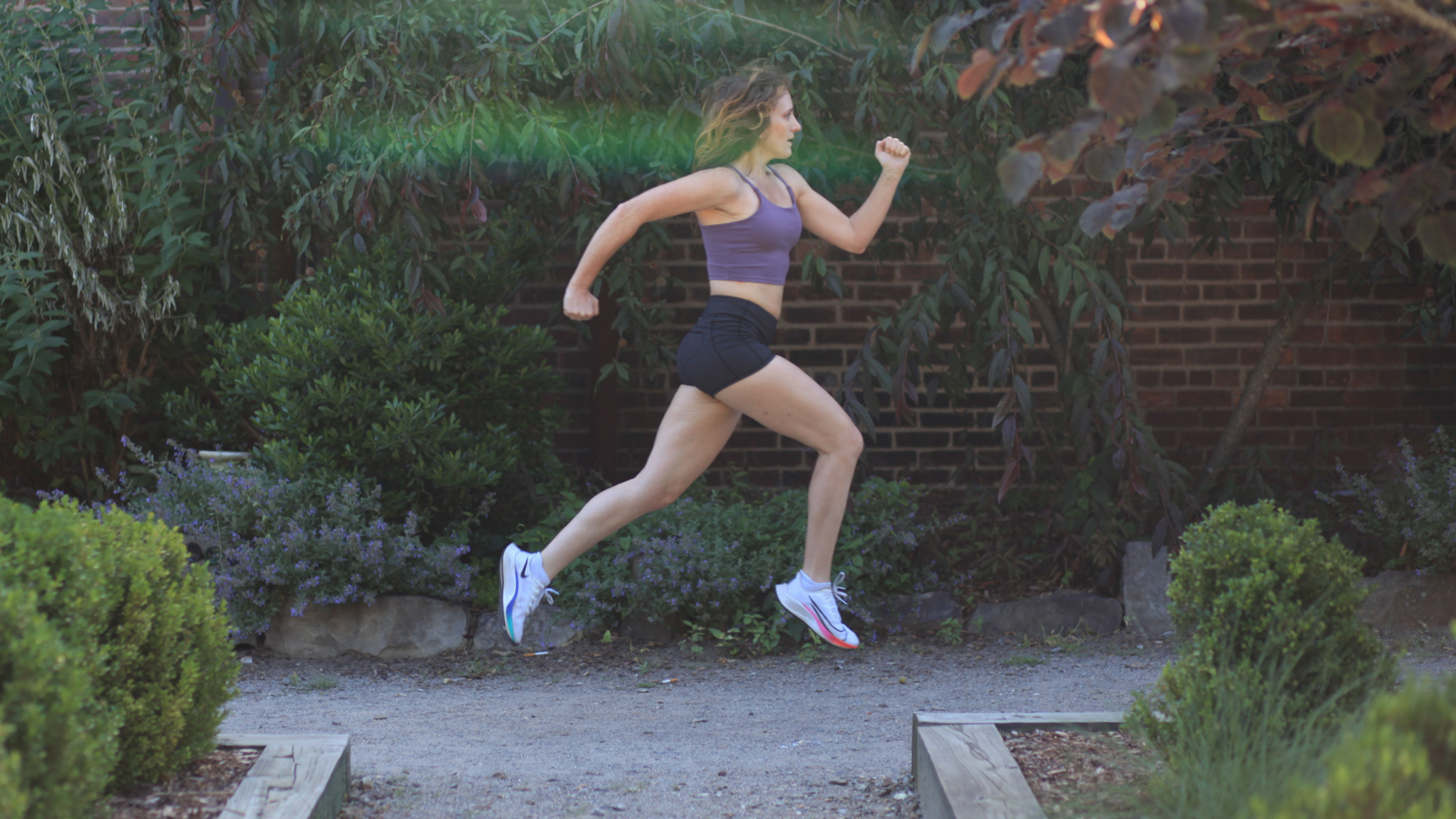You can actually lose weight with running, if you take the right approach to your training and nutrition.
Many people, myself included, picked up the running habit with one goal in mind–to lose weight. While the benefits of running can go far beyond losing a few pounds, running can be a fantastic part of your strategy to get in the best shape of your life.
So why is it that runners come in all shapes and sizes? If running is so good for weight loss, why aren’t all runners perfectly trim and lean? And what about those stories that you hear of people actually gaining weight while training for the marathon? (I did!) How is that even possible when you are pounding out mile after mile?
The easy answer is these runners must be just eating too much food. After all, the only way to lose weight is to burn more calories than you consume. That is a fact of physics.
So the simple solution is to eat less, run more, and voila perfect beach body guaranteed.
But so often it just doesn’t seem to work that way. So how do you actually lose weight with running?

Beyond Calories In and Calories Out
Let’s dive a little deeper beyond just calories in and calories out to explore why you might not be losing weight despite how much you run. And then, I’ll go over how you can change your routine and habits to finally achieve the results you are looking for.
Our bodies are adaptable, which is great because that means we can become better at running. But if you are running purely for weight loss, you’ll have to keep running more and more and more to get the same calorie burn as you did when you were an awkward and heavier beginner.
As you lose weight from running, you will not need as many calories to move through life, so your energy needs go down, meaning you need to eat even less to continue the weight loss. And it turns out, your body really doesn’t like to lose weight quickly, so it turns the fire down on your metabolism even further than your fancy watch or your fitness tracker would like us to believe.
So we run more, even though we are burning fewer calories per mile. If we are not aware that this is happening, we will continue to eat the same way and wonder why our weight has plateaued. But the really tricky thing is that even if we are perfectly aware of this phenomenon, we might still easily overcompensate with extra calories.
Compensation for Exercise
Compensation is the conscious or unconscious intake or absorption of more calories after a session of exercise. So that could mean having an extra brownie or two after your long run because you’ve told yourself you deserve it. Or that could be your body purposely ramping up your hunger hormones, suppressing your fullness hormones, and increasing your desire hormones, making that brownie absolutely irresistible.
While this is undoubtedly frustrating, don’t hang up your running shoes just yet. Countless people have lost lots of weight with running so how do they do it? What makes those runners different from the marathon runners that actually gain weight? I’ll get into that part next.
Focus on Your First Priority First
When trying to lose weight with running, the first thing to ask yourself is what are your personal goals? Is weight loss the main priority and you just happen to like running? Or is running the priority and weight loss would be nice too? Because the way you approach your running and your weight loss should be very different depending on your answer.
If you want to run faster and farther and happen to have some weight to lose, the best way to do that is to separate the two goals into different periods in the year. Just like weightlifters and football players have bulk phases and cut phases, you will want to plan a time in between specific race training cycles to lose weight. This ensures you aren’t in a calorie deficit when you are trying to build muscle and endurance for performance. For trained athletes, regardless of their weight status, it is incredibly difficult to lose fat and gain muscle at the same time. Not to mention underfueling is an express train to injury.
When weight loss is your goal, your running, training, and nutrition need to change away from a performance mentality. Of course, if you are a beginner runner, you can lose weight and get much better at running at the same time, but running should be part of the solution, not the entire goal itself.
Add Walking
As a new runner, you’ll want to ease into a running routine. Increase your running frequency, intensity, and distance gradually (and one at a time) to lower injury risk and get the best results. Because running is high-impact, overuse injuries are common if you add too much too soon and unfortunately, the risk of injury is even higher for heavier runners.
A great way to mitigate the injury risk and still burn lots of calories is to incorporate walking.
Compared to running, walking is less stressful on the bones, muscles and joints, yet it’s still stressful enough to create beneficial adaptations that will improve your ability to handle more running.
You might start off by walking only or with a mix of walking and running. Once things start to feel a bit easier after a few weeks, gradually shift the balance further and further toward running until you are comfortable with all running. The overall goal should be to aim for 300 minutes of brisk walking or running each week.
Bump Up Your Strength Training
The next key part of weight loss and body recomposition is strength training. Not only will strong muscles help you become a better, more resilient runner, but muscle is more metabolically expensive than fat. That means muscle will require more calories to grow and maintain, helping you burn more calories all day long.
A good strength program will work all of the major muscle groups and you should aim for about 60 minutes per week of lifting, which should be broken up into 2 or more sessions per week.
Here’s my FIVE MINUTE Strength Training for Runners video to get you started!
Boost Your Intensity
Another calorie torcher is high intensity interval training, or HIIT. This could be done by speedier intervals during your run once a week or with a separate plyometric or jumping session per week. HIIT has been shown to promote weight loss and it’s great for creating power in runners, but because of its intensity level, it should only be done about once a week.
Focus on Nutrition
Now that we’ve got the exercise plan down, we have got to talk about your diet. Many people will say that I’ve got it backwards and the food side is more important. Technically, that is probably true and I’m sure you have heard the phrase “you can’t outrun a bad diet.” But focusing on deprivation can make success much harder.

Kate Salina, a writer who lost 65 pounds with running, became a runner first without trying to change her diet. Rather than seeing running as simply a weight-loss tool, Kate chose to see running as something that could play a positive role in all aspects of her life, not just for what it could do on the scale..
“When I began running,” she said, “I deliberately focused on the running aspect rather than the weight loss element — and I did not consciously focus on my diet. The problem with trying to fix your diet while also starting to run is that you are asking yourself to do two tasks that both require limited willpower.”
In the first couple months of running, she noticed her energy levels rising and her moods were becoming much better, which caused fewer cravings to eat to feel better. She lost 20 pounds over the first two months, which she admits was partly due to water weight, but the success gave her the motivation to keep going and make better food choices.
Running is the Reward
For Kate, running became the reward, not the punishment and that is a mental mindshift every runner can benefit from. We don’t reward ourselves with junk food. We treat ourselves well with good running and good whole food.
That means we replace processed food like white flour and oils with more fruits, vegetables, lean proteins, and whole food. Swapping out low quality food with whole high nutrient foods will make you feel fuller and you’ll naturally cut calories when you make the switch.
High-quality foods with all their micronutrients and fiber are less energy dense and more satiating than low-quality, processed foods, so they fill you up with fewer calories. By increasing your overall diet quality, you can eat enough to satisfy your heightened appetite while still creating a calorie deficit required for weight loss.
Once you start training again for performance instead of weight loss, you still want to focus on high quality whole foods, but you’ll just want to begin to eat a little more of them.
Weight loss with running has been successful for many, many people and it all starts in the mind. Take a good look at your goals, your habits, and how you treat yourself, and you can achieve what you set your mind to.

